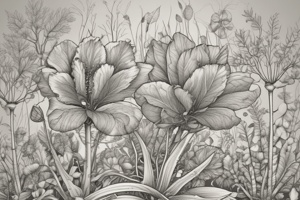Podcast
Questions and Answers
What is the primary function of meristematic tissue in a plant?
What is the primary function of meristematic tissue in a plant?
growth, differentiation, and development
What are the three main types of permanent tissue in plants?
What are the three main types of permanent tissue in plants?
simple, complex, and specialized tissues
What is the main function of xylem tissue in a plant?
What is the main function of xylem tissue in a plant?
transport of water and minerals from roots to leaves
What is the main function of phloem tissue in a plant?
What is the main function of phloem tissue in a plant?
What is the primary function of sclerenchyma tissue in a plant?
What is the primary function of sclerenchyma tissue in a plant?
What are the main functions of plant tissue?
What are the main functions of plant tissue?
Flashcards are hidden until you start studying
Study Notes
Plant Tissue Overview
Plant tissue is a group of similar cells that perform a specific function in a plant.
Types of Plant Tissue
Meristematic Tissue
- Consists of undifferentiated cells that can divide and differentiate into various types of cells
- Found in areas of growth such as tips of stems and roots
- Functions: growth, differentiation, and development
Permanent Tissue
- Consists of differentiated cells that have lost the ability to divide
- Can be classified into three main types: simple, complex, and specialized tissues
Simple Tissues
- Parenchyma Tissue
- Consists of living cells with thin walls
- Functions: storage, photosynthesis, and secretion
- Collenchyma Tissue
- Consists of living cells with thick walls
- Functions: support, structure, and flexibility
- Sclerenchyma Tissue
- Consists of dead cells with thick walls
- Functions: support, protection, and structure
Complex Tissues
- Xylem Tissue
- Consists of tracheids, vessels, and xylem parenchyma cells
- Functions: transport of water and minerals from roots to leaves
- Phloem Tissue
- Consists of sieve cells, companion cells, and phloem parenchyma cells
- Functions: transport of sugars and other organic compounds from leaves to roots
Specialized Tissues
- Epithelial Tissue
- Consists of cells that cover the surface of the plant
- Functions: protection, absorption, and secretion
- Muscle Tissue
- Not found in plants
- Nerve Tissue
- Not found in plants
Functions of Plant Tissue
- Support and structure
- Transport of nutrients and water
- Storage of food and water
- Photosynthesis
- Protection and defense
- Secretion and excretion
Plant Tissue Overview
- Plant tissue is a group of similar cells that perform a specific function in a plant.
Meristematic Tissue
- Consists of undifferentiated cells that can divide and differentiate into various types of cells.
- Found in areas of growth such as tips of stems and roots.
- Functions: growth, differentiation, and development.
Permanent Tissue
- Consists of differentiated cells that have lost the ability to divide.
- Can be classified into three main types: simple, complex, and specialized tissues.
Simple Tissues
- Parenchyma Tissue
- Consists of living cells with thin walls.
- Functions: storage, photosynthesis, and secretion.
- Collenchyma Tissue
- Consists of living cells with thick walls.
- Functions: support, structure, and flexibility.
- Sclerenchyma Tissue
- Consists of dead cells with thick walls.
- Functions: support, protection, and structure.
Complex Tissues
- Xylem Tissue
- Consists of tracheids, vessels, and xylem parenchyma cells.
- Functions: transport of water and minerals from roots to leaves.
- Phloem Tissue
- Consists of sieve cells, companion cells, and phloem parenchyma cells.
- Functions: transport of sugars and other organic compounds from leaves to roots.
Specialized Tissues
- Epithelial Tissue
- Consists of cells that cover the surface of the plant.
- Functions: protection, absorption, and secretion.
- Muscle Tissue and Nerve Tissue are not found in plants.
Functions of Plant Tissue
- Support and structure.
- Transport of nutrients and water.
- Storage of food and water.
- Photosynthesis.
- Protection and defense.
- Secretion and excretion.
Studying That Suits You
Use AI to generate personalized quizzes and flashcards to suit your learning preferences.




